Tipica '73 soon signed a deal with the Inca label, resulting in the release of their self-titled debut only a year after they originally formed. The group hit upon a fresh and intoxicating sound, as they combined the conjunto percussive style (congas, timbales, and bongos) with a horn section, and, in the process, became one of the salsa movement's leading outfits to hail from New York. A sophomore effort quickly appeared (like their debut, it was also titled Tipica '73), which spawned the hit single Amalia Batista, a cover tune that was originally made famous by Rolando La Serie. But more importantly, the album signaled the debut of a new member, tres player Nelson Gonzalez, who would become an integral member of the outfit.
The group's third release, 1975's La Candela, further helped to establish Tipica '73 as one of the world's top Latin outfits, and is often singled out as the most important (and best) of the group's long career. Soon after, original leader Rodriguez Jr. handed the reins over to Sonny Bravo, as he decided to focus on collaborating with musicians living in Cuba. 1976 saw the release of Rumba Caliente, an album produced by the renowned Latin percussionist/arranger Louie Ramirez, and spawned such hits as Pare Cochero, Sonaremos el Tambor, and Guaguanco de los Violentos. The group's fifth release overall, The Two Sides of Tipica '73, is widely considered to be their most musically experimental, as such styles as salsa, charanga, bolero (merged with an orchestra, nonetheless), songo a la Ritmo Oriental, and Latin jazz can be detected throughout.
Salsa Encendida was issued in 1978, which saw the group follow in the same direction as their previous release, but it would be Tipica '73's next release that proved to be a major step forward. Since a few years prior, Rodriquez Jr. had regularly come in contact with some of Cuba's finest musicians during his musical expeditions there, scouting local talent. And on Tipica '73's final release of the '70s, 1979's Tipica '73 en Cuba, Intercambio Cultural, Rodriguez put his findings to use, as he recorded the album entirely in Cuba with his newfound talent from the country (which was no easy feat at the time, due to the U.S. and Cuba's tense political relationship). The move was met with some resistance from certain members of Tipica '73, but Rodriguez pushed forward with his plan nonetheless. Although commendable, the group was subsequently given a hard time by club owners in the U.S., who subsequently refused to book the band, fearing ticket loss due to boycotts.
The '80s began on a less controversial note, with a tribute to the charanga style, 1980's Charangueando con la Tipica '73, which included standout versions of Tito Puente's A Donde Vas and Cachao's Chanchullo, among others. Tipica '73 issued another album the same year, Into the 80's, which featured a plethora of special guests, including appearances by Latin jazz pioneer Mario Bauza, Puerto Rican percussion greats Rafael Cortijo and Kako, singers Roberto Torres and Nestor Sanchez, cuatro player Yomo Toro, and percussionist Roger Squitero, among others. But the strain of 1979's controversy had worn the group out, as bandleaders Bravo and Rodriguez Jr. decided to end Tipica '73 in 1982. Not much was heard from the group afterward, as most of the group's members focused on session work and appearances on other artist's recordings. But in 1995, Tipica '73 reunited for a successful concert in Puerto Rico, which led to a series of shows four years later. ~ Greg Prato, Rovi











